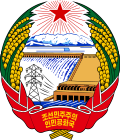Paektu Mountain
Paektu Mountain (also called Baekdu Mountain) or Changbai Mountain is a volcano on the border between North Korea and China.[2] This mountain is 54.5% in North Korean territory, 45.5% in China. The Korean name is Paektu-san or Baekdu-san, which means "white head mountain". The Chinese name is Changbai-shan, which means "snow that piles up on the large mountain".
 Paektu/Baekdu/Changbai Mountain volcano, April 2003 | |
| Elevation | 2,744 metres (9,003 ft) |
|---|---|
| Location | |
| Location | Ryanggang, (North Korea) Jilin, (China) |
| Geology | |
| Type | Stratovolcano |
| Last eruption | 1903[1] |
Paektu has a large caldera (crater lake). It is called Heaven Lake. Koreans call it "Cheon-ji" lake, Chinese call it "Tiandi" lake. It is 2,744 metres above sea level and is the highest mountain of all Korea. The Beijing Olympic torch was lit on Paektu/Changbai Mountain. Heaven Lake is a caldera made by a gigantic volcanic eruption in 969 AD (± 20 years) which had a Volcanic Explosivity Index (VEI) of 7.[3][4] The 969 eruption, which is called the "Millennium" or "Tianchi" eruption, was one of the most violent eruptions in the last 5,000 years, comparable to the 180 AD "Hatepe eruption" of Lake Taupo and the 1815 eruption of Mount Tambora.[5]
Paektu Mountain Media
Mount Paektu on the national emblem of North Korea.
Painting from the Manchu Veritable Records with the names of Mount Paektu in Manchu, Chinese and Mongolian
Map showing the Chinese-North Korean border region around Paektu Mountain
References
- ↑ Smithsonian Institution Global Volcanism Program: Baitoushan
- ↑ Baekdu Mountain (白頭山)/Changbai Mountain(长白山)
- ↑ Horn, Susanne; Schmincke, Hans-Ulrich (2000). "Volatile emission during the eruption of Baitoushan Volcano (China/North Korea) ca. 969 AD". Bulletin of Volcanology. 61 (8): 537–555. doi:10.1007/s004450050004. S2CID 129624918.
- ↑ "Global Volcanism Program | Changbaishan". Smithsonian Institution | Global Volcanism Program. Retrieved 2023-02-06.
- ↑ Pan, Bo; Xu, Jiandong (2013). "Climatic impact of the Millennium eruption of Changbaishan volcano in China: New insights from high-precision radiocarbon wiggle-match dating" (PDF). Geophysical Research Letters. 40 (1): 54–59. Bibcode:2013GeoRL..40...54X. doi:10.1029/2012GL054246.
| Wikimedia Commons has media related to Lua error in Module:Commons_link at line 62: attempt to index field 'wikibase' (a nil value).. |








